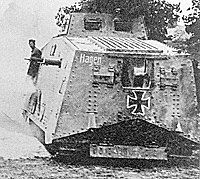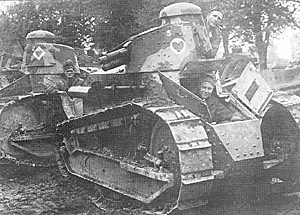On March 21, 1918, the great German offensive hit 43 miles of the Western Front with an opening salvo of artillery and gas, followed by special shock troops trained to bypass strongpoints and advance into the rear areas. Sixty-three German divisions with four German and five captured and refurbished Mark IV tanks were committed against 28 British divisions, driving up to 40 miles by April 5 and taking 80,000 prisoners. On April 9, a fresh attack in Flanders met with success, driving 10 miles deep on a 30-mile breadth into the British sector. Both eventually were countered and stopped by the end of the month, including notable service from British tanks.
 On April 24, the Germans tried a limited offensive on a four-mile frontage at Villers-Bretonneux to try and capture high ground and threaten the important rail junction at Amiens. Four of the new storm divisions were used, to be spearheaded by 13 of the new A7V tanks (right). Three of them from Group 3, commanded by Lts Wilhelm Biltz (the Nixe), Albert Muller (Schnuck), and Friedrich-Wilhelm Bitter (Siegfried), lumbered out of the early morning fog leading German infantry towards British lines. A section of three British tanks commanded by Capt. F. C. Brown, one male Mark IV tank under 2nd Lt. Francis Mitchell and two female Mark IV tanks, had been stationed in a nearby woods, the Bois l'Abbe. In addition, seven Whippets were nearby.
On April 24, the Germans tried a limited offensive on a four-mile frontage at Villers-Bretonneux to try and capture high ground and threaten the important rail junction at Amiens. Four of the new storm divisions were used, to be spearheaded by 13 of the new A7V tanks (right). Three of them from Group 3, commanded by Lts Wilhelm Biltz (the Nixe), Albert Muller (Schnuck), and Friedrich-Wilhelm Bitter (Siegfried), lumbered out of the early morning fog leading German infantry towards British lines. A section of three British tanks commanded by Capt. F. C. Brown, one male Mark IV tank under 2nd Lt. Francis Mitchell and two female Mark IV tanks, had been stationed in a nearby woods, the Bois l'Abbe. In addition, seven Whippets were nearby.
Villers-Bretonneux: First Tank vs. Tank Battle
With Villers-Bretonneux captured, the A7Vs rumbled past the Bois de Hangard heading for the Cachy-Fouilloy Road west of Villers-Bretonneux. Brown ordered a counterattack and the three Mark IVs advanced around 8:45am as visibility improved, reaching the Cachy area around 9:30am. Mitchell saw the three A7Vs, one about 400 yards away and two more further away to the south. He moved to attack, turning right along the trench line so his left sponson 6 pounder manned by Carter could fire at the German tank. He turned around upon meeting the two female tanks, zigzagging and avoiding shellholes, and now his right-hand gunner, Sgt. MacKenzie, fired at the German tank, to no effect.
The female Mark IVs, armed only with machine guns, soon found themselves unable to penetrate the German armor, however Biltz' gunners soon holed one of the females. These two Mark IVs turned about and withdrew. Meanwhile, Mitchell continued to zigzag, track, and shoot at the German tank, sticking his head out the top hatch for a better view and finally halting his movement at about 10:20am. This gave a stable platform for his gunners, who soon got the range and hit the Nixe three times in rapid succession. The German gunner was killed, two others fatally wounded, three more slightly wounded, and the crew abandoned the Nixe.
As for the other two A7Vs, Bitter and Muller had been held up at Cachy as their infantry support went to ground. They backed off. Mitchell, thinking them gone, went back to patrolling the Cachy line and shooting up German infantry. However, the two A7Vs had not retreated very far.
The Whippets, commanded by Capt. T.R. Price, were advised of German infantry by a message dropped from a British reconnaissance airplane. Price and his Whippets advanced quickly, entering the area at 11:00am and proceeded to machine gun German infantry. The Whippets came over a small ridgeline, 300 yards in front of Bitter, who had ordered his tank forward to support the infantry. The gunner for the Siegfried calmly shot at the Whippets--one burst into flames, and then a second. A third was disabled and the rest turned and fled, only to have a fourth break down. The Schnuck and Siegfried then retired as the German attack petered out.
As for Biltz, his driver noticed the Nixe still running. The crew soon re-entered the machine and drove it back towards German lines, getting two miles down the road before the engine seized. Mitchell's luck ran out around 12:45pm when a mortar shell hit a track and stopped the tank. He and his crew abandoned the vehicle. At about 2:30pm, Bitter and Muller reappeared to shell Cachy, but could not jumpstart the attack and soon trundled away. The first tank versus tank battle ended. Mitchell was later awarded the Military Cross.
Follow Up
Although German attacks would continue, including a July 15 attack on the French, Ludendorff's opportunities were slipping away. On the 16th, the French stopped the Germans cold, and on the 18th, launched a blistering counterattack. A total of 211 St. Chalmonds and Schneiders plus 135 Renaults gained four miles in one day, although losing 100 tanks from German fire and breakdowns while the rest were extremely low on fuel.
The British and French hammered the Germans in August and September, advancing steadily and steadily taking prisoners. From when the Battle of Amiens opened August 8 through the end of August, strong tank support (604 tanks) and short advances with quick consolidation netted 70,000 German prisoners as the Allies hit, then broke, the Hindenburg Line.
 US troops in two-man Renaults.
US troops in two-man Renaults.
On September 12, 1918, the American Tank Corp went into action for the first time in attacks on the St. Mihiel salient. The 304th Tank Brigade, equipped with 174 Renaults, smacked into the salient, but bungled the approach and petrol resupply efforts. Nonetheless, defensive resistance was feeble as the Germans decided to pull back. On the second day of battle, the American tanks didn't encounter the Germans at all, while on the third day of the offensive, they were engaged in mop-up operations. The unit withdrew altogether intact, having suffered one destroyed tank, 22 ditched tanks, 14 breakdowns, and minimal casualties. Later operations in cooperation with British and French tank units proved more fruitful.
On October 8, 1918, the Germans launched a tank counterattack at Niergnies, scraping up one A7V and 10 captured British Mark IVs. In another trading of shots at ranges as close as 50 yards, tanks on both sides were disabled, the Germans coming off somewhat the better in numbers, the British losing four tanks versus the Germans losing two, but ultimately defeated in advancing further. And while the German inventory of tanks remained relatively static, the Allied reserves grew and grew.
A month later, on November 11, 1918, an Armistice was declared and the First World War ended.
More Tank Development
- Introduction
Precursors to the Tank
Early Designs: 1332-1912
The British Develop the Tank
The First Tank Attack
French Development, Arras, and German AT
Battle of Cambrai
Ludendorff Offensive and the First Tank vs. Tank Battle
Conclusion
Back to War Lore: The List
Back to Master Magazine List
© Copyright 2002 by Russ Lockwood.
This article appears in MagWeb (Magazine Web) on the Internet World Wide Web.
Other military history articles and gaming articles are available at http://www.magweb.com